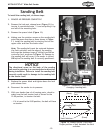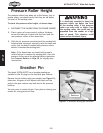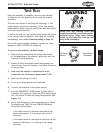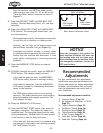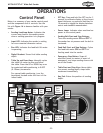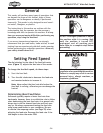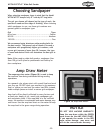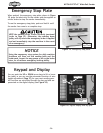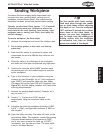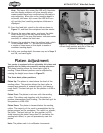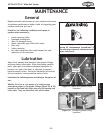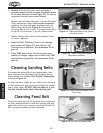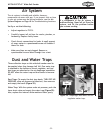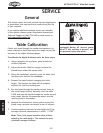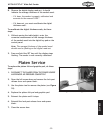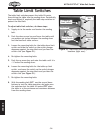
-27-
W1756/W1757 43" Wide-Belt Sander
OPERATIONS
To achieve the best sanding results experiment with
conveyor feed rate, sanding depth, various grits of
sandpaper, and oscillation speed. Also, make sure the
workpiece has been jointed and planed before sanding.
Typically, no more than 0.5mm (approx.
1
⁄64") of material
is removed during each pass. Attempts to remove too
much material can cause jamming, wood burning, rapid
sandpaper wear or tearing, poor finish, short motor life,
and belt slippage.
To sand a workpiece, do these steps:
1. Measure the workpiece and record the thickest spot.
2. Put on safety glasses, a dust mask, and hearing
protection!
3. Make sure the sander is connected to power and
compressed air and turn
ON the dust collector and
the sander.
4. Raise the table to the thickness of the workpiece
and make an initial pass to eliminate any high spots.
5. Continue to raise the table 0.0625" between each
successive pass until the sander begins to sand the
entire workpiece.
6. Type in the thickness of your workpiece using the
numeric key pad (Example: for a 2" thick workpiece
type 2.000"), and press the table start key.
Note:
The upper left corner Input LED will illuminate (See
Figure 20), and the display numbers will flash when
entering measurements.
7. Measure the sanding depth needed. Example: let’s
say you need
1
⁄64 ".
8. Convert
1
⁄64" fraction to a 0.016" decimal
measurement using the conversion table on the
sander.
9. Calculate the resulting workpiece thickness (2.000"—
0.016" = 1.984"), and type that thickness (1.984") on
the key pad.
10. Press the table start key: The table will raise to the
new setting.
Note: The computer rounds the sanding
thickness measurements in increments of 0.005",
and if you want to move the table up in 0.005"
increments, just tap the up arrow. The same holds
true for the down button.
Sanding Workpiece
For best results when finish sanding,
feed each piece through the sander
two or three times without adjusting
the depth of cut. Turn the workpiece
180˚ and feed it through two or three
more times at this same depth. As
always, use your best judgement. If
you no longer hear the sanding belt
making contact with the workpiece
on successive cuts, then no further
passes are needed at that depth.
Tip



